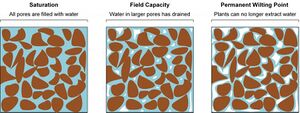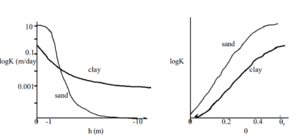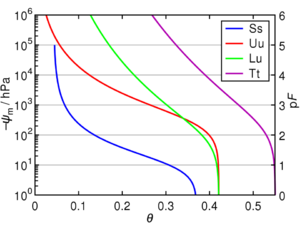
Difference between revisions of "Soil hydrologic properties and processes"
| Line 32: | Line 32: | ||
===Soil infiltration=== | ===Soil infiltration=== | ||
| − | [[File:Conductivity vs water content.png|300px|thumb|alt=image of conductivity vs water content|<font size>Generalized curves of hydraulic conductivity as a function of water content for a sand and a clay. Image: [https://lawr.ucdavis.edu/classes/ssc107/SSC107Syllabus/chapter4-00.pdf University of California, Davis]</font size>]] | + | [[File:Conductivity vs water content.png|300px|thumb|alt=image of conductivity vs water content|<font size=3>Generalized curves of hydraulic conductivity as a function of water content for a sand and a clay. Image: [https://lawr.ucdavis.edu/classes/ssc107/SSC107Syllabus/chapter4-00.pdf University of California, Davis]</font size>]] |
Soil infiltration refers to a soil's ability to allow water movement into and through the soil profile. Infiltration is important to movement of solutes, including pollutants, and to recharge of groundwater. Some basic terms include the following. | Soil infiltration refers to a soil's ability to allow water movement into and through the soil profile. Infiltration is important to movement of solutes, including pollutants, and to recharge of groundwater. Some basic terms include the following. | ||
Revision as of 16:08, 23 June 2021
This page is not yet developed
Soil hydrologic (hydraulic) properties include infiltration and water retention. These properties significantly affect plant growth, pollutant transport, and subsurface water transport (e.g. groundwater recharge).
Soil water and water retention

Soil properties related to water content and water retention are critical to plant establishment and growth. Understanding some basic terms related to soil water is important to understanding water storage and transport. These terms are illustrated in the adjacent schematic.
- Soil water (moisture) content can be expressed on a mass or volume basis. This video describes the two measurements and how they are related.
- Gravimetric water content: the ratio of the mass of water held in the soil to the dry soil.
- Volumetric water content: the ratio of the volume of water to the unit volume of soil. Volumetric water content can be expressed as a ratio (e.g. cm3/cm3), percentage (e.g. 50% of the soil volume), or depth of water per depth of soil (e.g. centimeters per meter of soil).
- Example: assume a wet soil weighs 50 grams, a dry soil 40 grams, and soil bulk density is 1.3. Gravimetric water content is ((0.5-0.40)/0.40) = 0.10/0.40 = 0.25 g/g. To derive volumetric water content, multiply the gravimetric water content by the bulk density and divide by density of water (1.0 g/cm3). Volumetric water content is therefore 0.25*1.3/1.0 = 0.325 cm3/cm3, or 32.5%.
- Water holding capacity: the total amount of water a soil can hold at field capacity.
- Field capacity: the amount of soil moisture or water content held in the soil after excess water has drained away and the rate of downward movement has decreased. Physically it is the water content retained in soil at −33 kPa (or −0.33 bar) of hydraulic head or suction pressure.
- Wilting point: the volumetric water content in the soil is too low for the plant's roots to extract water. When the water content of a soil is below the permanent wilting point, water is still present in the soil, but plant roots are unable to access it. Physically, it is the water content at −1,500 kPa (−15 bar) of suction pressure.
- Moisture retention curve: the relationship between the water content (θ), and the soil water potential (ψ), typically expressed as a curve. The curve is characteristic for different types of soil and is therefore also called the soil moisture characteristic.
Water infiltrates a dry soil through both gravitational forces and suction forces exerted by soil materials. Water is held in soil by suction forces exerted by materials such as clay. Water not held under suction drains freely due to gravitational forces. The time for a soil to drain due to gravity varies depending on soil texture and structure. Sands drain more quickly than clays because of more direct, well-connected drainage pathways. A soil's field capacity, or the amount of water remaining after gravity drainage, varies with soil and is not a exact value. Typical field capacity for sandy soils is 0.10-0.15 cm3/cm3 and for clays is about 0.3 cm3/cm3. Water subject to gravity drainage is available to plants, but because drainage occurs rapidly in most soils (less than 48 hours), it is generally not an important source of water to plants. Below field capacity, plant roots must exert force to extract water held to soil. As a soil dries, the amount of suction required increases until a plant can no longer extract water, typically at about-15 bars. This is called the wilting point. Water between the wilting point and field capacity is plant available water. Typical plant available water is about 0.10 cm3/cm3 for sand and clay and about 0.15-0.20 for loams. The lower values for sand is due to low water content of the soil, while the low value for clays is due to clays tightly holding water.
Water content can be measured in the lab or in the field. For point-in-time measurements, lab methods are satisfactory, being easy to take and inexpensive. Continuous measurements of soil water content require in-field methods that are often expensive and sometimes subject to inaccuracies. For information on sampling for water content, link here.
For more reading
- Soil water status: content and potential
- Understanding Soil Water Content and Thresholds for Irrigation Management
- Water content
- Soil and water
Soil infiltration

Soil infiltration refers to a soil's ability to allow water movement into and through the soil profile. Infiltration is important to movement of solutes, including pollutants, and to recharge of groundwater. Some basic terms include the following.
- Infiltration rate: a measure of how fast water enters the soil, typically expressed in inches or centimeters per hour. Although infiltration rates are often provided for different soils, the infiltration rate varies with soil water content and the rate of water application. Infiltration rate values provided in the literature typically represent infiltration rates under saturated soil conditions.
- Hydraulic conductivity: a measure of how easily water can pass through soil or rock. High values indicate permeable material through which water can pass easily, while low values indicate material that is less permeable. Conductivity varies between different soils and with water content of a soil.
- Saturated hydraulic conductivity: the amount of water that would move vertically through a unit area of saturated soil in unit time under unit hydraulic gradient. Considering water as the fluid, it is a constant for a given soil.
- Permeability: permeability has different meanings. While it often is used to describe the ease with water passes through a soil, in geophysical applications it is a quantitative property controlled solely by pore geometry. This is often called intrinsic permeability and it is independent of fluid viscosity and density.
